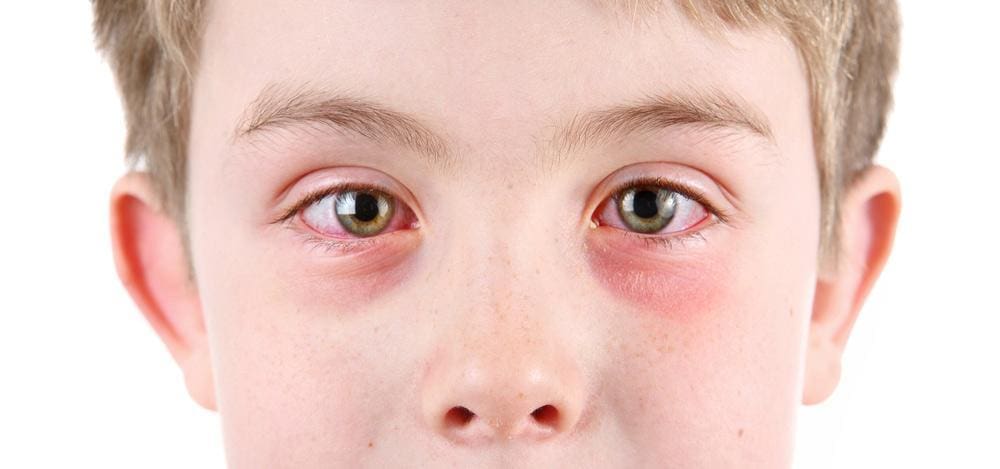https://maplegroveeye.vision/signs-that-you-need-to-see-an-eye-doctor-about-pink-eye/
7 Signs You Need To See an Eye Doctor for Pink Eye (Conjunctivitis)
Pink eye, also called conjunctivitis, can happen to people of all ages, but it is most common in children. The symptoms of a mild case of pink eye might include:
- Redness and itching
- Excessive tearing
- Swollen eyelids
- Watery discharge from one or both eyes
- A gritty feeling in the eyes
- Increased light sensitivity
Normally, these symptoms go away within two weeks. In other cases, you need to see an eye specialist right away, not just an MD in the ER or at Urgent Care. Let’s take a look at a few scenarios that would require immediate professional attention.
1. If a Chemical Caused the Pink Eye
It is normal for soap or shampoo to irritate your eyes. However, if something else has gotten in your eyes, such as house cleaners, paint, or pesticides, you need to get to an eye doctor right away. If something gets into your child’s eyes, then immediately take your child for pediatric eye care. Many chemicals can cause blindness, so treat it as an emergency.
2. If the Patient is a Newborn Baby
Pink eye in newborn babies is usually due to a tear duct that has not opened completely. Sometimes, the tear duct will open on its own. Pink eye could also be caused due to a sexually transmitted disease contracted by the mother. An eye doctor familiar with pediatric eye care can better show you how to massage your baby’s eye to help open the tear duct or care for a case from an alternative cause or more severe cases.
3. Intense Pain
Pink eye is painful, but it should not be crippling. It may be concerning if your eyes feel sore to the touch, accompanied by severe headaches and brow aches. If it does, contact your family eye doctor right away. You should also get someone to drive you to and from your appointment.
4. Vision Changes
A little blurring is normal when it can be resolved by rubbing the eye. However, your eye should not be blurry all the time. You should also not see flashes, halos, vision loss, or double vision. Being extra sensitive to light can also be concerning. If the vision loss seems severe and persistent, seek medical attention right away.
5. Wearing Contact Lenses Overnight
Often people can develop pink eye from wearing contact lenses overnight or not disinfecting the lenses when wearing them. Remember, disposable lenses must not be reused, and other contacts must be used only with the recommended cleaning solution. See an expert if you suspect you have pink eye due to contact lenses.
6. Allergic Reaction
One of the most common causes of pink eye is an allergic reaction. The blood vessels in the conjunctiva can dilate, leading to swelling and inflammation due to allergy-causing substances like pet dander, pollen, molds, and dust mites. The immune system overreacts to these substances developing intense itching and burning sensations. Eye drops can help, but if you see no relief, time to visit an eye doctor.
7. Persistent Discomfort
Along with pain and blurry vision, you might experience yellow or green discharge from the eyes, indicating a more serious issue. The discharge can make your eyes crusty, especially in the morning when you wake up. If the symptoms do not go away even after two weeks (three weeks in case of viral conjunctivitis), it is time to see a specialist.
Pink Eye Complications
Most cases of pink eye are mild, and the irritation clears up in a week or so. Generally, pink eye doesn’t require medical intervention. Practicing proper hygiene and using at-home or doctor-suggested treatment methods can provide significant relief.
In rare cases, pink eye has long-term consequences, causing blindness. This is when pink eye leads to scarring of the eye. Pink eye infections have been known to trigger potentially deadly meningitis infections. It can also lead to other bodily infections, especially if you or your child is immunocompromised.
Pink Eye Treatment
There isn’t any one specific treatment for viral conjunctivitis. Your immunity takes care of it and clears the infection in a few days. A specialist could help speed up the recovery process. However, mild cases of bacterial pink eye can take up to two weeks. Your doctor would prescribe antibiotic drops to fight the infection and any discharge.
The AAO Journal researched 300,000 cases and found that. Turn to an optometrist for comprehensive, convenient medical eye care.
With allergic pink eye, the symptoms will improve once the root cause is fixed. Lubricating eye drops can relieve the discomfort, but you must identify and avoid the triggers.
Apart from caring for the eyes, make sure you are not spreading the infection. Practice good hygiene, avoid touching the eyes, and avoid sharing personal items like cosmetics, towels, lenses, etc.






